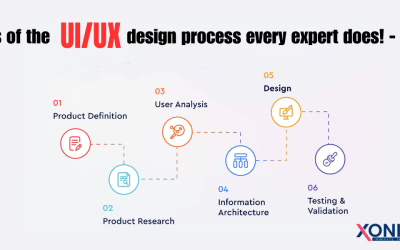Imagine visiting a site that is difficult to navigate, cluttered in its layout, and visually uninteresting. How does this make you feel? You are likely to lose interest and quit the website rapidly. That’s where the UI/UX concept is crucial. Designing UI/UX is like building bridges that connect users with the service. An effective UX/UI Design Services will lower bounce rates and increase customer engagement. Indeed, 88% of internet customers are less likely to revisit a website after an unpleasant user experience.
The UX/UI Services is responsible for designing an interface users can relate to and providing an effortless experience that keeps customers interested in your business. By using it, you’ll achieve the top factors of user engagement, such as clarity, consistency, personalization, and emotional impact.
With the constantly evolving digital world, user interaction has become essential in using digital goods and services. User Interface (UI) and UX Experience (UX) Design have crucial roles in generating memorable and enjoyable experiences that attract users and generate significant interactions. UX/UI design services profoundly affects the user experience. This article will outline the methods and guidelines for building memorable experiences.
What Exactly Is UX/UI Design?
One of the best ways to comprehend these concepts is to learn the meaning behind each by themselves:
UI refers to the user interface. It refers to the interactivity and visual elements of electronic interfaces like websites and apps. UI design is how the features appear and function on-screen displays. UX refers to the user experience. It refers to the experience a consumer has with the services offered by a company. UX design takes care of this by ensuring that the user experience is pleasant for potential customers when they encounter the product or service of a company.
These are the most important aspects to consider when creating a site application, an email address, or an interactive digital interface. Making these two components the primary focus is essential for believing in any initiative you take.
UI/UX Design: The Key Differences
However, even though UX/UI Design Services are closely connected, they are often combined into UX/UI design, and different professionals might be involved in every design. Like any other area of expertise, the smaller your specialty and the more deeply you dive into it, the more excellent, high-quality results you can deliver. Recently, designers can focus on only one aspect of design, whether UX or UI.
For an excellent idea of how the responsibilities can be assigned, here’s a concrete scenario you can apply in UX design. If you enter a house, the living room will be the first thing you’ll see, not the bathroom. The switches for lighting are located on the walls, not the ceiling. The UX designer defines what a person can expect to do with various elements within the website or app and also the steps needed for a user to arrive at a particular stage. The UI specialist is responsible for the appearance of these elements, while the UX designer determines the general customer experience, architecture, and logic.
Thus, a UX specialist’s knowledge includes conducting market research, developing the right design, and managing the whole task. A UI specialist can be described as an interactive designer, and they are occasionally also a web developer.
What Is User Engagement, And Why Is It Important?
You need to realize that your service or product should engage with customers to help you earn as many dollars as you would like. Tomorrow or today, your product will slide into the mud. Engagement is the process of keeping users returning. It’s the art of creating an experience or product that is engaging enough that customers can’t stop being involved with it. Imagine a picture that you cannot keep your eyes off of. It’s hard not to return to it, trying to understand its significance. It’s called user engagement.
Think of a tune that cannot be removed from your mind. It’s a song you can’t stop humming for hours. User engagement makes something so engaging and valuable that people can’t resist engaging. This is crucial for various reasons. One reason is that it will help increase the number of visitors to your site and sales. When visitors are happy with your product or service, they are likelier to remain there longer and purchase.
Engaging users can help you build a more enduring relationship with your customers. Customers feel like they belong to an online community when they are active. They’re more likely to endorse your service or product to their family and friends, which will ultimately help you develop a superior product that customers will appreciate.
Benefits That Come From UX And UI To Increase User Interaction
The advantages of UX and UI in increasing user engagement can be immense. As engagement is a crucial factor, the factors that bring users to this need to be considered.
Here are some benefits UX and UI design services provide for engagement with users.
Wider Accessibility
The consequences of poor accessibility and increasing mobile device use are not overlooked. The accessibility requirement is global, so your site and mobile application must have a full load on the accessibility front. UX and UI design services focus on ensuring greater accessibility, essential to people with disabilities. The user experience is more enjoyable on a web page open to everyone.
Enhances First Impression
It takes an average of 2.6 seconds to arrive on the website. This makes it essential for companies to make a great impression. Design is a fundamental component and aspect that makes a great impression. If your UI is visually appealing, you will make a great first impression and be closer to increasing user interaction.
Better Usability
In addition to enhancing first impressions, UI/UX Design Services are well-known for improving the user experience, even making it more accessible. As users gain an advantage at each stage, the user experience will be significantly simplified. This increases the level of engagement and general value that a website or app can create for users.
Strengthens The Brand Image
UI UX can create a brand image and then solidify it to the point of brand memorability. It also makes a solid branding identity that inspires confidence and builds an enduring user base. When these components are mixed, the result will increase longer-term brand loyalty and help drive business expansion.
Increased Conversion Rate
UI UX is credible in increasing conversion rates because it streamlines navigation, boosts the mobile experience, adds personalization, and provides a sense of uniformity throughout the interaction. When the user experience is precisely modeled, visitors can obtain what they need from a site. Increased conversion rates can create incredible excitement about engaging, thus reinforcing passion for engaging.
Competitive Edge
Mobile applications or websites that are easily accessible, create positive first impressions, are user-friendly, have strong brand identities, and increase conversion rates can gain an edge in the competition. In consolidating UI UX and maximizing its capabilities for engagement with users. Your business will be able to expand over a wide area and as the primary source for meeting business objectives.
The Three Pillars Of User Engagement
We must understand the most critical elements of user engagement.
Cognitive Engagement
It means the user’s comprehension and understanding of the information they interact with. An effective UI design ensures that the information you provide is simple to comprehend, reducing cognitive disengagement and generating enthusiasm for your product or service.
Emotional Engagement
Emotional involvement is just as significant, covering positive emotions such as happiness and satisfaction and negative emotions like anger. Implementing a design for UI/UX that stimulates positive feelings while decreasing negative experiences can significantly affect users’ satisfaction and loyalty.
Behavioral Engagement
The primary purpose of UI/UX design is to increase behavior-based engagement by encouraging users to buy products, share information with friends, or offer feedback. An effortless user flow, user-friendly navigation system, and clear call-to-action are essential.
Maximizing User Engagement with the Power Of UI/UX Design Services
Implement these methods by implementing these strategies. You can create unforgettable experiences that will resonate with the users you serve and contribute to your digital service’s longevity.
Understand Your Target Audience
Engaging in UI/UX Designing Services begins with a solid comprehension of your intended audience. Complete a thorough investigation to discover the needs, preferences, and issues. Design user profiles to assist you in empathizing with your customers and help inform your design decisions. Furthermore, divide your user base according to gender, age, geographic location, and other interests for a better-designed and appropriate user experience. If you can meet the demands of each group, it will result in an engaging and enjoyable overall experience for every user.
Set Clear Goals and Targets
Find the most important goals you wish your users to accomplish in your application. These objectives will guide you through the entire design process, ensuring that each element of your UX/UI design services contributes to user interaction and happiness. Align your design preferences to these goals and prioritize options to help users complete them quickly. Strike the proper harmony between ease of use and efficiency, as an overly complicated interface could overwhelm users and inhibit involvement.
Take A Mobile-First Stance
As more people rely on smartphones, it’s vital to prioritize mobile users during design. Consider a mobile-first design approach and ensure your UX/UI works seamlessly on all screens and devices. This approach will enable you to serve a broader range of users and improve user interaction. Remember that mobile users typically experience different requirements and needs than desktop users. Create mobile-friendly navigations, optimize target areas for touch, and optimize content consumption to improve mobile user experience and increase engagement.
Concentrate On Accessibility and Usability
Customer engagement relies heavily on an easy and user-friendly user experience. Ensure you adhere to the established design principles, including sameness, feedback, and transparency. Also, accessibility should be considered to ensure that users with different capabilities and preferences can use your website.
Ensure your content is concise and clear, including keyboard navigation, and use descriptive alt text for images to make an inclusive and appealing experience for the broadest range of people. Be aware that a usable and accessible design does not just help people with disabilities. However, it also improves the experience of every user.
Make Use of the Potential of Micro-Interactions
Micro-interactions are tiny, proper responses or animations that take place as the users interact with your service. They can significantly increase user satisfaction by offering rapid feedback that reinforces users’ actions and brings joy to the experience. Use micro-interactions to guide users throughout your application, inform users of the progress of your product, or give a personality to your designs. Take care of harmony between usability and aesthetics and avoid excessive usage of micro-interactions, which can distract users and distract them from the principal goals of the product.
Customize User Experiences
Personalizing your product can create a connectedness between your products and the customers. You can tailor your recommendations, content, and user interface based on the user’s preferences, behavior, habits, and characteristics. The targeted approach will increase the participation and satisfaction of users.
Utilize machine learning techniques and data analysis to spot patterns in user behavior so that you can provide personalized experiences tailored to those you serve. Also, it will enable users to personalize their experience, for example, selecting their preferred language or changing the interface’s settings for greater participation.
Make Sure That Your Page Loads Quickly
An interface that could be faster to load could hinder a user’s engagement. To improve your site’s operation speed, compress images, minimize the code, and use cached browsers. Speedy-loading pages provide an enjoyable and seamless user experience. Also, consider implementing lazy loading strategies to delay loading less critical elements until required. This will ensure that the content with the highest importance gets priority, increasing the impression of performance and the probability of user engagement.
Encourage User Feedback
Feedback from users is essential for better understanding how your intended audience views your product and identifying areas that need improvement. To gather insights and improve the designs, utilize feedback methods like surveys, user testing, and tools for in-app feedback. Recognize user feedback and demonstrate your dedication to continual enhancement to develop a sense of trust. Participate actively with users in the development process and make them feel appreciated and valued, boosting engagement and loyalty.
Always Test and Tweak
Always analyze the performance of your product and its engagement metrics to pinpoint the areas in need of focus—test A/B to play using different elements of design and then make informed decisions to increase user engagement. Engage users during the testing procedure through usability tests, focus group discussions, and conversations to gain direct insight into their experience. Make sure to adopt an iterative method to ensure that user needs, and market trends change constantly. Be adaptable as you learn of new trends and shifting user needs, being ready to adjust your approach in response to both.
Enhancing the user’s engagement through UI/UX design services is a continuous process that requires continual iteration and improvements. By understanding the audience, you want to reach by prioritizing user-friendliness and implementing the techniques we have discussed above, you can develop a compelling and engaging product that is a delight to your customers and keeps them returning to return. Be aware that focusing on the user experience is not an isolated effort. It’s an ongoing dedication to constantly improving your product and providing outstanding experiences that are distinctive from the crowd of digital products.
Best Practices to Apply to Improve User Experience and Engagement
You now know why UX and UI design are important in your website and app design; you must adhere to the most effective guidelines to ensure you’re making a user-friendly product. The following are some of the best methods to be aware of:
- Make your site design with your primary users, focusing on what they expect to look at. What are you doing to help users to browse your site? Be aware that users are the primary people to consider when designing. Thus, it is essential to consider user experience as well as the interface for users.
- Use user-centric principles for visuals. If users are browsing and experiencing your website, their visual experience will be the primary factor in their interactions with your site and branding. Therefore, it is essential to use the appropriate colors, fonts, images, spacing, and layout so that your visitors have a satisfying experience.
- Make sure your site is easily accessible. If it’s difficult to navigate, your customers will be less likely to visit your application or website. Easy, user-friendly navigation can greatly improve users’ journeys. Additionally, you should consider inclusiveness and making your site accessible to users who are deaf, blind, or have disabilities.
- Given the pace at which people’s lives may be, they’re more likely to leave your site if it doesn’t load in an hour. Be sure to optimize the speed of your website by compressing images or decreasing plugin usage, so it performs at an equivalent pace with industry benchmarks.
Measuring The Impact of UI/UX Design Services
One of the most essential elements of evaluating the effects of design and UI services is using key metrics and data. Relevant insights derived from data can help companies determine the efficacy of their design strategy. Key performance indicators (KPIs) provide valuable metrics to evaluate customer engagement, conversion rate, and task completion rate.
They provide concrete evidence of how users receive the design and meet its goals. By regularly analyzing and interpreting these data points, businesses can determine areas that need improvement, improve the user experience, and enhance their digital offerings or services to more efficiently satisfy users’ expectations. Analytics and metrics are crucial instruments that allow for continual improvement and empower companies to constantly improve and adapt their approach to design as time passes.
Beyond the analytics and metrics, user reviews and feedback are also crucial factors in determining satisfaction with the user. User feedback and reviews provide valuable insights and personal experiences that are far more than quantitative information. Businesses can utilize various techniques like surveys, usability tests, or feedback methods to collect customer feedback.
This approach encourages users to discuss their ideas about their preferences, needs, and areas, helping businesses better understand their requirements and preferences. Companies can pinpoint improvement points and quickly respond to problems when actively listening to their users’ comments. Utilizing an iterative design process based on user input encourages a more user-centric strategy that ensures ongoing satisfaction and trust. Through valuing and implementing the feedback of users, companies can create stronger relationships with the people they want to reach and continually enhance the user experience.
In a Nutshell
The level of engagement that users experience in UX/UI design services is critical in determining the quality of your product’s performance and endurance in the digital marketplace. It isn’t just to create a pleasing product but to provide an experience that connects with users, meets their requirements, and keeps their attention. Knowing your target audience, setting specific goals, implementing a mobile-first approach, focusing on accessibility and usability, using the power of micro-interactions, and personalization are the most essential methods to increase customer engagement.
Optimizing loading time and encouraging feedback will dramatically enhance your overall user experience and make connecting with your target audience easier. Regular testing and iteration using performance metrics and user feedback will ensure your website is current with users’ changing needs, demands, and market trends.
The engagement of users is not an unchanging goal but a continuous and evolving procedure. It demands constant improvement, creativity, and attention to users’ needs and experiences. When you implement these techniques to improve your digital products, you can be distinguished from the digital market, delivering unique experiences that delight your customers, increase loyal customers, and contribute to the success over time of your service. Success in user interface/experience design lies in making every interaction valuable, pleasurable, and comforting for its target user audience.








